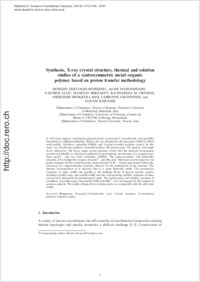Synthesis, X-ray crystal structure, thermal and solution studies of a centrosymmetric metal-organic polymer based on proton transfer methodology
- Eshtiagh-Hosseini, Hossein Department of Chemistry, School of Sciences, Ferdowsi University of Mashhad, Iran
- Hassanpoor, Azam Department of Chemistry, School of Sciences, Ferdowsi University of Mashhad, Iran
- Alfi, Nafiseh Department of Chemistry, School of Sciences, Ferdowsi University of Mashhad, Iran
- Mirzaei, Masoud Department of Chemistry, School of Sciences, Ferdowsi University of Mashhad, Iran
- Fromm, Katharina M. Department of Chemistry, University of Fribourg, Switzerland
- Shokrollahi, Ardeshir Department of Chemistry, Yasouj University, Iran
- Gschwind, Fabienne Department of Chemistry, University of Fribourg, Switzerland
- Karami, Elham Department of Chemistry, Yasouj University, Iran
-
13.05.2010
Published in:
- Journal of Coordination Chemistry. - 2010, vol. 63, no. 18, p. 3175-3186
English
A 3-D metal-organic coordination polymer based on pyrazine-2,3-dicarboxylic acid (pzdcH₂) formulated as {[Mn(pzdc)(H₂O)₂] · 2H₂O}n (1), was obtained by the treatment of MnCl₂ · 6H₂O with pzdcH₂, 8-hydroxy quinoline (8-HQ), and 2-amino-4-methyl pyridine (ampy). In this study, we describe the synthesis, elemental analysis, IR spectroscopy, TG analysis, and single X-ray diffraction. The X-ray single crystal structure reveals that the chemical environment around each Mn(II) is a distorted octahedral by participating one nitrogen, five oxygens from three (pzdc)²⁻ and two water molecules, O₅MnN. The centrosymmetric 1-D ladder-like structure of 1 is bridged by oxygens of (pzdc)²⁻, and Mn-pzdc-Mn bonds are the rungs for our ladder structure. In the crystal structure, intermolecular O-H ··· O hydrogen bonds result in the formation of a supramolecular structure, effective for the stabilization of the structure. The thermal decomposition of 1 indicates that it is quite thermally stable. The protonation constants of ampy, 8-HQ and pzdcH₂ as the building blocks of proton transfer systems including pzdcH₂-ampy and pzdcH₂-8-HQ and the corresponding stability constants of these systems were determined by potentiometric study. The stoichiometry and stability constants of complexes of pzdcH₂-ampy and pzdcH₂-8-HQ with Mn²⁺ were investigated by this method in aqueous solution. The results obtained from solution study are comparable with the solid state results.
- Faculty
- Faculté des sciences et de médecine
- Department
- Département de Chimie
- Language
-
- English
- Classification
- Chemistry
- License
-
License undefined
- Identifiers
-
- RERO DOC 20556
- DOI 10.1080/00958972.2010.508518
- Persistent URL
- https://folia.unifr.ch/unifr/documents/301699
Statistics
Document views: 145
File downloads:
- pdf: 217
